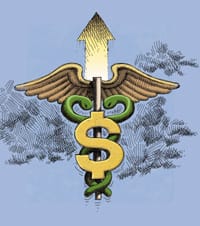Street Sense: The fundamentals of stock market investing
Demographics to Spur Eye Care
Population trends are a key to identifying winning stocks. Aging "baby boomers" could boost some eyecare companies.

BY JERRY HELZNER
Smart investors are aware of population trends. It's these trends that can tell us which companies are going to be enjoying increased business in the future and which companies may languish.
In business, population trends are usually referred to as "demographics." For example, when birth rates are high, the demographics for the baby food and toy businesses are excellent The larger number of infants and children creates additional demand for these products.
This month, I'll discuss how demographics may affect the future performance of ophthalmology-related stocks.
The jump in the U.S. birth rate from an average of 3 million newborns a year in the early 1940s to about 4.5 million births a year in the 1950s created the economic force known as the "baby boom generation." These boomers have had an enormous and continuing impact on business and social institutions as they've progressed through the various stages of their lives.
BOOMERS MEAN BUSINESS
At different times, the boomers have been responsible for a spike in new school construction, a peak in college enrollment and a surge in homebuilding.
Now, as the vanguard of the baby boomers reaches the age of 55, this massive cohort is approaching a stage of life during which they'll become major consumers of ophthalmology services. Michael J. Parshall of the Health Care Group, Inc., which provides management advice to ophthalmology groups across the country, estimates that the number of cataract procedures performed in this country each year will increase by about 33% to more than 2.2 million by 2006. Parshall says the number of retinal procedures should climb at an even faster rate.
Assuming that a large percentage of baby boomers will live well into their 70s and 80s, the future of ophthalmology and the businesses that largely serve the eyecare needs of seniors should be assured for at least the next 25 years.
How can an astute investor take advantage of this demographic trend?

FROM SOLID TO SPECULATIVE
Clearly, we should begin by looking at the leading eyecare companies with the broadest product lines. This category includes Alcon, Bausch & Lomb and Advanced Medical Optics, which consists of the ophthalmic surgical and contact lens care businesses that were formerly part of Allergan.
Because Allergan is now a specialty pharmaceutical company with participation in such areas as Botox and nonophthalmic drugs, it falls into a second category of companies. These firms have significant interests in eye care but also participate in other areas of health care.
Also in this second category are such companies as Johnson & Johnson, Novartis, Pharmacia, Becton Dickinson and Merck.
A third category is made up of smaller, more specialized firms, such as those developing an advanced ophthalmic device or pursuing new pharmaceutical concepts. STAAR Surgical belongs in this group. Companies in the third category are more speculative, but can be big winners if they come up with a truly innovative product or service.
CHOOSING A PORTFOLIO
Given the demographic trends in eye care, the broad-based eyecare companies should be in an excellent position to outperform the overall market. The more diversified companies I named will also benefit from increasing demand for pharmaceuticals and health care.
Some of the smaller, more speculative companies may have a place in your portfolio, particularly if you have personally used their products and/or services and find them outstanding.
Ophthalmology Management Associate Editor Jerry Helzner has written more than 50 articles on stock investing for Barron's. He has been a regular stock market columnist for other business publications and was a member of the equity research department of a major regional brokerage firm.








